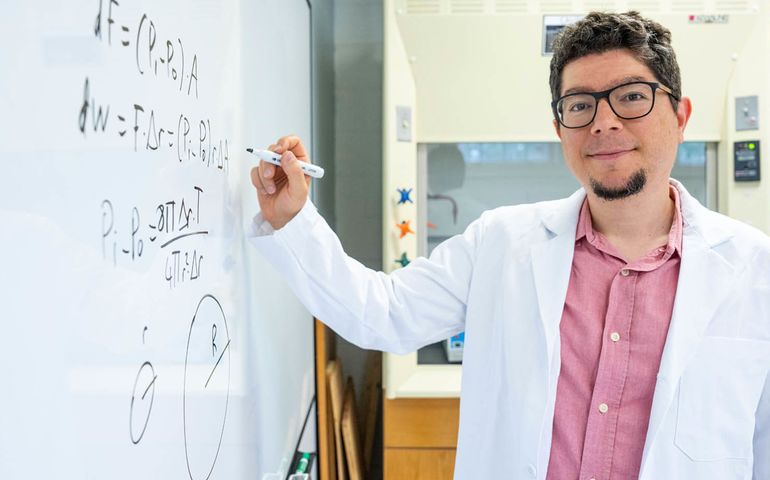UMaine to lead research on life support ‘nanobubbles’ for space exploration
 Courtesy / University of Maine
Onur Apul at the University of Maine is leading a project to explore whether “nanobubbles” can support space exploration, including water treatment on spaceships, and perhaps other applications such as aquaculture and paper manufacturing.
Courtesy / University of Maine
Onur Apul at the University of Maine is leading a project to explore whether “nanobubbles” can support space exploration, including water treatment on spaceships, and perhaps other applications such as aquaculture and paper manufacturing.
The University of Maine is leading a project to explore whether “nanobubbles” can support space exploration, including water treatment on spaceships. The $1.1 million multi-institutional investigation is backed by NASA.
Nanobubbles — ultrasmall pockets of oxygen, carbon dioxide, hydrogen and other gases, suspended in liquids — might even serve industries important on the ground and water in Maine, such as paper manufacturing and aquaculture.
“We are creating the infrastructure, the backbone, for nanobubble research in Maine,” said Onur Apul, an assistant professor of environmental engineering at UMaine and the project’s lead researcher. “This is only the beginning of it.”
According to Apul, nanobubbles can be generated in liquids with simple instruments that oscillate liquids, as well as through other hydraulic, physicochemical and electrochemical methods.
This results in mixtures known as biphasic liquids — those that take the forms of both a liquid and gas.
Apul said that, due to their size, nanobubbles possess unique properties that might improve the efficiency of life support functions on spaceships, particularly water treatment and growing algae to provide oxygen and nutrition for astronauts.
The diameter of a nanobubble is less that 100 nanometers. A nanometer is equal to one-billionth of a meter.
Unlike regular bubbles that float to the surface of a liquid, nanobubbles can suspend in it for hours, days or even months. Apul said they also possess a high surface area and high reactivity, but are also malleable, making them ideal for chemical reactions. Those aspects allow nanobubbles to provide reliable and accessible storage for various gases, which could support and reduce the energy cost of water treatment and other systems on earth and possibly in space, he said.
To determine whether nanobubbles can benefit life support systems beyond Earth’s atmosphere, Apul and his team must ensure they can withstand micro- and zero gravity, as well as the conditions of fluids in those environments. The research will focus on nanobubbles of oxygen, hydrogen, nitrogen, ozone and other atmospheric gases.
Researchers will first generate nanobubbles in biphasic liquids with existing and new equipment at UMaine. The bubbles will then be tested in a high-altitude balloon, which can travel up to 118,000 feet or more, through UMaine’s High Altitude Ballooning Program; The researchers will also conduct tests of the bubbles' stability with a small research satellite called a cubesat, and in two rocket launches.
The company blueShift Aerospace in Brunswick will work with researchers on the launches for the cubesat, which will be built at the WiSe-Net lab in the UMaine Electrical and Computer Engineering Department, as well as the two rocket launches, Apul said. One rocket will travel 62 miles and another will ascend 186 miles.
Eventually, researchers hope to test their biphasic liquids with nanobubbles by sending them to the International Space Station, Apul says.
“It’s very theoretical now, but we believe this could shift the paradigms of using gases in unconventional situations,” Apul said. “This is a novel research area that is only 10 years old, and the potential it has is exciting. My slogan for them is ‘tiny bubbles, massive potential.’”
The project received a $753,750 grant from NASA’s Established Program to Stimulate Competitive Research (EPSCoR), through the Maine Space Grant Consortium.
It was matched with a $350,000 cost share contribution provided by participating institutions, which included UMaine, the University of Southern Maine and Arizona State University.
The project team includes Apul; Ali Abedi, UMaine associate vice president for research and professor of electrical and computer engineering; Sergi Garcia-Segura; assistant professor of environmental engineering at Arizona State; and Ashanthi Maxworth, an assistant professor of environmental engineering at USM. They will collaborate on the project with researchers from NASA’s Johnson Space Center.
Apul has been studying nanobubbles for two years and worked with various stakeholders interested in their development, including a distillery in Texas. Some of his students also are involved in nanobubble research.
The new study is expected to help answer fundamental questions about nanobubbles, after which researchers can springboard into investigating other possible applications for them on Earth and beyond, Apul said.
Three doctoral students, two in Maine and one in Arizona, and up to five undergraduate researchers are expected to work on the study. New equipment purchased through this research will complement existing tools and expand the capacity for scientists at both UMaine and USM to investigate nanobubble production, characterization and application, Apul said.













0 Comments